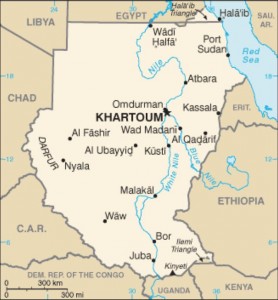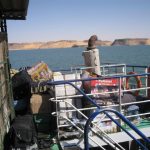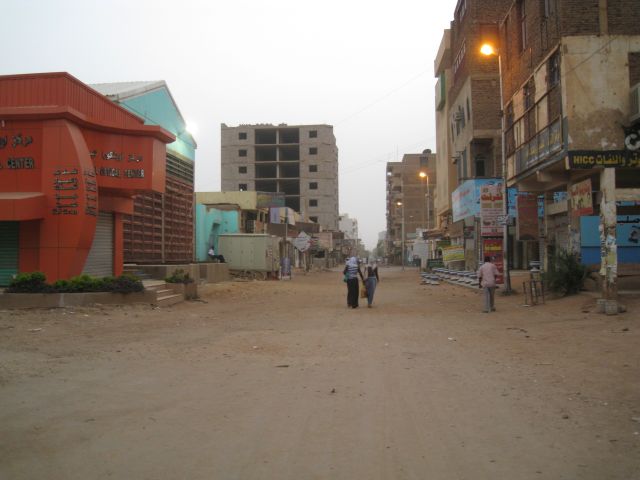Wegen gründlicher Investigation, sowie zeitaufwendigen kulturspezifischen Beobachtungen und Begegnungen im ostafrikanischen Uganda, geht dieser Kulturkanal in seine wohlverdiente verspätete Sommerpause. Unsere kleine Redaktion, Weiterlesen
Wegen gründlicher Investigation, sowie zeitaufwendigen kulturspezifischen Beobachtungen und Begegnungen im ostafrikanischen Uganda, geht dieser Kulturkanal in seine wohlverdiente verspätete Sommerpause. Unsere kleine Redaktion, Weiterlesen
Das Ende von Äthiopien. Moyale im Süden, rund 25.000 Einwohner. Ein geteiltes Grenznest, eine Hälfte äthiopisch, die andere, noch staubigere Hälfte kenianisch. In der Mitte gibt es einen Holzbalken als Grenzmarke. Jeder lebt mehr oder weniger auf seiner Seite. Und das – obwohl es unter den Moyalern, bei Vorzeigen des Personalausweises freien Grenzverkehr gibt. In wenigen Tagen findet ein gemeinsamer Jugendmarathon statt, verkünden Lautsprecher und ein über die Hauptstraße gespanntes Spruchband. Verbinden soll er, die beiden Völker! Weiterlesen
Programm Vorschau: In der nächsten Ausgabe soll auf jenem dadaistischen Kulturkanal, für alle Ewigkeit geklärt werden, warum das Debütalbum der Stone Roses aus dem Jahre 1989 und das erste Velvet Underground Album, unter der Mitwirkung der Chanteuse Nico, aus dem Jahre 1967, unantastbar als die besten Musikalben der Popkultur gelten. Weiterlesen
Angekommen im geschichtsträchtigen Harar, einer tausendjährigen Stadt im islamischen Osten von Abessinien. Für die Muslime ist sie angeblich nach Mekka, Medina und Jerusalem die viertheiligste Stadt der Welt. Die einst für Ungläubige verbotene Stadt, ist immer noch von der alten Stadtmauer umgeben, die sie vor dem christlichen Einfluss schützte. 6 Tore gebieten Einlass und über 100 Moscheen soll es geben. Ein großer Teil der Bevölkerung stellen die Flüchtlinge, des nicht weit entfernten krisengeschüttelten Somalia. Weiterlesen
Sie lebt und fährt immer noch! Und das nach weit über 40 Jahren. Leider kaum noch in Deutschland, dafür aber erstaunlicher Weise in Addis Abeba, der hochgelegenen und regnerischen Hauptstadt des ehemaligen Abessiniens. In Addis, wie man hier zu sagen pflegt, ist Sie immer noch ein willkommener Lastesel und gehört zum alltäglichen Straßenbild. Produziert wurde Sie, soweit ich weiß, vor allem in den 60er und 70er Jahren und konnte bis zu einer Tonne Last transportieren.
Der luftgekühlte Heck Antrieb Weiterlesen
 Getting a visa for the unknown Sudan is not an easy affair. One of the best places to get a visa, if you intend to enter the Sudan via the overland route is Cairo. I paid $100 in Cairo which is the standard fare for most nationals. A letter of recommendation from your embassy and the obligatory passport photos are required. Since the Sudan referendum of partition, the German embassy does not issue any more such letters. I made my own letter of ‘no recommendation with the help of my laptop, and it did work! I heard that the Sudanese consulate in Aswan, apparently charges only $50 and does not even ask for such stupid letter! Try your luck.
Getting a visa for the unknown Sudan is not an easy affair. One of the best places to get a visa, if you intend to enter the Sudan via the overland route is Cairo. I paid $100 in Cairo which is the standard fare for most nationals. A letter of recommendation from your embassy and the obligatory passport photos are required. Since the Sudan referendum of partition, the German embassy does not issue any more such letters. I made my own letter of ‘no recommendation with the help of my laptop, and it did work! I heard that the Sudanese consulate in Aswan, apparently charges only $50 and does not even ask for such stupid letter! Try your luck.
 The ferry from Aswan in Southern Egypt to Wadi Halfa in the Northern end of the Sudan will cost $60 in the cheapest class and leaves every Monday in the late afternoon. The 560 tickets sell fast, so be there early enough. Remember, without a Sudanese visa you can’t buy a ticket. The trip over the lake Nasser, takes around 20 hours while checking onto the ferry can take another 8 h. Try to be there early to get a seat, since the ferry is notoriously crowded and overloaded with Sudanese traders and their goods from Egypt. When the ferry is finally ready to leave, it’s so packed; there is hardly space to move on deck. In the early next morning, the ferry captain whistles the horn when passing by Abu Simbel, watch out – I missed it! Sudanese people are quite friendly and honest and a breeze after the greedy Egyptians. You will notice this immediately after arrival.
The ferry from Aswan in Southern Egypt to Wadi Halfa in the Northern end of the Sudan will cost $60 in the cheapest class and leaves every Monday in the late afternoon. The 560 tickets sell fast, so be there early enough. Remember, without a Sudanese visa you can’t buy a ticket. The trip over the lake Nasser, takes around 20 hours while checking onto the ferry can take another 8 h. Try to be there early to get a seat, since the ferry is notoriously crowded and overloaded with Sudanese traders and their goods from Egypt. When the ferry is finally ready to leave, it’s so packed; there is hardly space to move on deck. In the early next morning, the ferry captain whistles the horn when passing by Abu Simbel, watch out – I missed it! Sudanese people are quite friendly and honest and a breeze after the greedy Egyptians. You will notice this immediately after arrival.
Sudan is a very bureaucratic country, probably the most bureaucratic in the world! When you arrive in the dusty land, you have to register at the Foreign Alien Office within 3 days, which sets you back with another $40, slightly less if paid in SP. You have to obtain a travel permit, which is actually free of charge and a photo permit which is $10. This later includes a lot of restrictions and doesn’t allow you to photograph many things anyway. The exceptions are listed on the permit. Before you can check into a hotel anywhere in the country you have to register again at the nearest police office, at every place you visit! Some locanda owners will copy your documents and will do it for you, so.
Sudan is dusty, hot and very little developed in most parts. Proper hotels in Sudan are quite expensive. So if you want to save some money, you should consider staying in local locandas, small guesthouses, often without a sign, rather simple but sufficient. Most people in Sudan or let’s say men will speak some English, enough for travelling and much better than for instance in China. Haven’t talked actually to any woman in Sudan!
The roads in the Northern Sudan all the way from Wadi Halfa to Ethiopia are in rather good condition, some of them have been redone just recently with the help of the Chinese. There are a few interesting places to visit along the Nile on the way to Ethiopia where the Blue Nile starts. Interesting stopovers could be Dongola, Karima on the way to Khartoum and Kassala in the East, near the Eritrean border. The Eritrean land border is closed! Well anyway, not considering the previous mentioned places, the most direct trip from Wadi Halfa to the Ethiopian border at Metema will take about 30 h and will cost around 150 Sudanese pounds, the equivalent to $50.
Notice, there are no ATM’s in Sudan or any possibilities to change traveller checks. Cash US Dollars are King. The best rates you will get on the somewhat behalf legal black-market, where the best rate I got for 1 US$ was 3,2 Sudanese Pounds (in May 2011). Prices: A glass of tea will cost 1 SP, a cheap meal starts from 3 Pounds for mashed beans and 10 SP for half a chicken, one liter bottle of water 2 SP and a private room in a locanda goes from 20 up to 70 SP. Dormitory may be cheaper.
Midway Calculation: From Germany to Ethiopia by public transport (train, bus and ferry) will cost you around €360. Travelling time on public vehicles is around 183 h. This does not include waiting times at borders, harbors or other transport stations, which can be quite time consuming. It does also not include taxi rides to get to these stations. It has taken me around 2 months, travelling in a rather slow pace and visiting major sights on the road to reach Ethiopia.
You have to add another €180 on visa fees for Syria, Jordan, Egypt, Sudan and Ethiopia. This includes registration fees in Sudan as well as exit and harbor fees and so on. Just for the ones who want to know how much an overland trip to Ethiopia might cost!
Schon eigenartig?! Da kommt man über kleinere Hürden und den üblichen Ungereimtheiten, dann doch so ziemlich genau nach zwei Monaten, wie einst noch in der trauten Heimat geplant, über endlos staubige und holperige Pisten, tatsächlich im ehemaligen Abessinien – dem orthodox christlichen Äthiopien an. Nach fünf muslimischen Ländern in Folge, angefangen mit der Türkei bis hin zum Sudan, ist dieses Abessinien schon eine ganz andere Welt. Plötzlich sind sie weg, die Kopftücher und Verschleierungen. Das wachsame Auge Allahs ist verschwunden!
Der erste Eindruck soll ja oft ein anderer, manchmal sogar ein unverfälschterer sein, als der darauffolgende: Weiterlesen
Der Sudan hat mich immer schon gereizt, nicht weil es da etwa etwas zu sehen gäbe. Ich glaub es war vielmehr, dass ich kaum etwas darüber wusste, man nie eine Dokumentation oder sonstiges zu Gesicht bekam. Sehen wir mal von den spärlichen Informationen ab, die wir über die Krisenregion Darfur erhalten oder über Juba – die neue Hauptstadt des abtrünnigen christlichen Südens. Jede Kultur eines Landes entwirft ja eine gewisse Ästhetik, nennen wir es eine Straßenszenerie.

Strassen Szenerie in Khartoum am fruehen Abend. Die wohl staubigste Hauptstadt auf unserem Planeten. Entertainment not allowed! Sharia rules!
Landestypische Straßenszenerien sind Unikate – bestehend aus Gesichtern, Dress Codes, Abgaswerten, Automarken, Unrat, Bewegungen und Geräuschen – um nur einige Merkmale zu nennen… Weiterlesen
7 lange Tage musste ich in Assuan, der südlichsten Stadt Ägyptens, in der Agatha Christi einst den Krimi ‚Tod auf dem Nil‘ geschrieben hat, verbringen. Schöne charakteristische Nillandschaft mit idyllischen Inseln, Katarakten und wohl den verdorbensten Menschen in ganz Nubien. Nubien, so bezeichnet man den südlichen Teil Ägyptens und den nördlichen Teil des Sudans. Hier im Süden verliert der Ägypter auch allmählich seinen arabischen Einschlag. Die Gesichtszüge werden runder und afrikanischer, das Haar krauser, die Haut dunkler… Weiterlesen